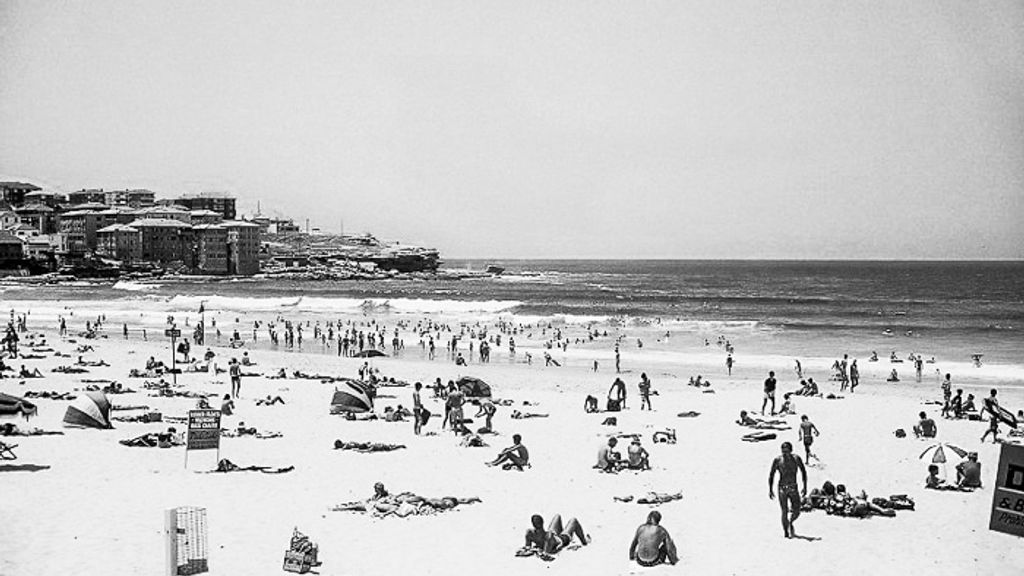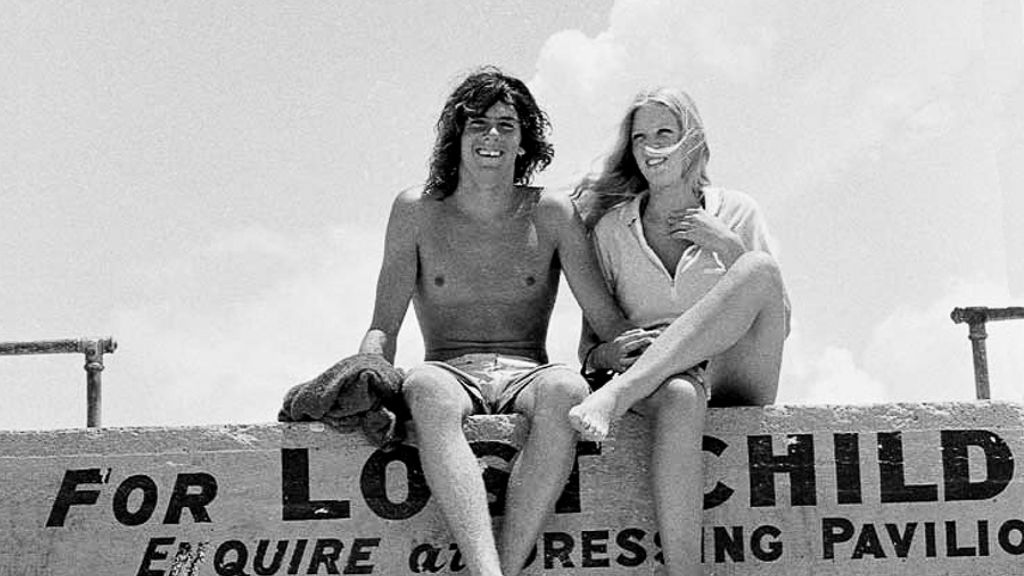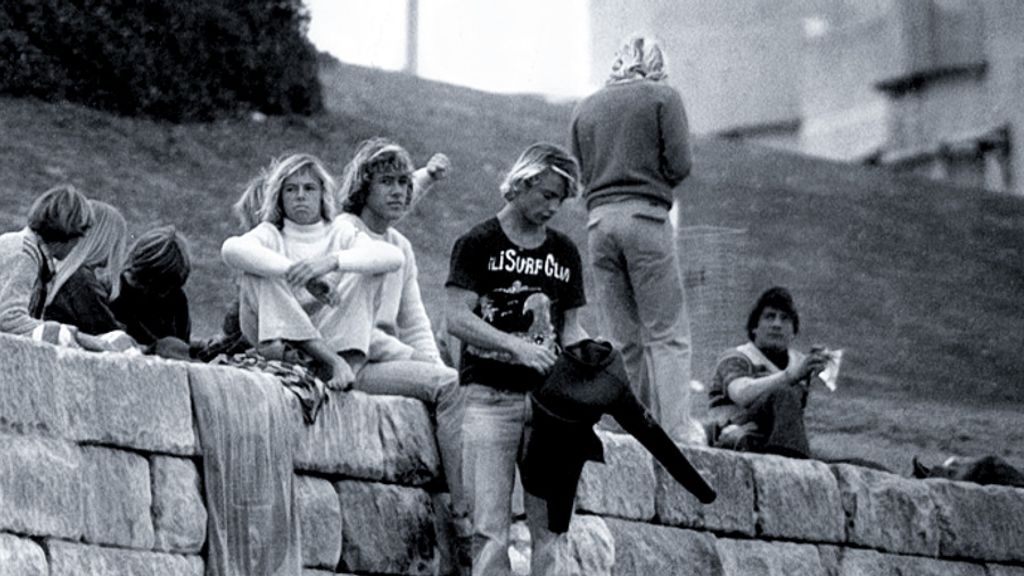“BONDI (CONCRETE) SOUL,” BY GEOFF LUTON (1970)

Geoff Luton’s “Bondi (Concrete) Soul” feature ran in the May 1970 issue of Surfing World. This version has been slightly edited.
* * *
When Albert suggested I do a story on Bondi for SW I must admit that at first I had a number of evil thoughts about his motives. I first thought that he must be really short of material to want an article on such a colorless place as Bondi. Then I thought he was simply joking, or maybe even out of his head (literally of course). Finally, I thought that perhaps he was only trying to get rid of me — all you Superman fans out there will be familiar with the “junior reporter ejection technique,” as applied by Perry White on Jimmy Olsen, when he sends the youngster off on some dud assignment or other to get rid of him.
But despite my initial negative reaction at the prospect of Bondi being suitable SW material, I decided to give the idea a try, and after a deal of stimulating and stimulated thought (stimulated by the fantastic voice of Robert Plant and the music of Led Zeppelin and Led Zeppelin II, as well as by a number of other stimulants which shall remain unnamed to protect the guilty) I came to the conclusion that the best way to survey the Bondi scene and get to the soul of the place was to spend a whole day there and report on what I saw.
So this is the result.
The most striking features of Bondi at 5 a.m. on a midsummer Monday morning, are it’s many famous landmarks. The spray-covered mermaids on Big Rock at Ben Buckler survey the whole scene with dumb contempt. The blocks of flats on the northern headland, extending almost down to the sea, give the whole place a Riviera-type look in the early morning light. The dull white sand, still bathed in shadows, seems to mock the dirty discolored water oozing out of the sewerage or rainwater outlet at the southern end of the beach (actually, I am not sure what the hell that big gaping hole in the concrete is over there, but it turns me right off) and flowing into an already discolored sea. Funny how Sydney’s two most famous beaches, Bondi and Manly both feature major sewerage outlets.
I look back towards the old flats and apartment houses in Campbell Parade, and at the simple but quaint shops running almost the entire length of the beach; then at the new bachelor apartments and other assorted home units, and the 35-flavor ice-cream parlors that are rapidly springing up here and there, and I realize it won’t be too long before the “old” completely disappears, replaced by the “new” (like the American style of doing things). I am sure that the “new” Bondi will lose much of its character and atmosphere.


I take a walk along the ugly grey concrete promenade and think to myself just how grotesque the typical metropolitan beach frontage is. I notice that the beach seems unusually crowded for how early it still is. There are the inevitable beach runners, sweating for health and God knows what else, while rock pool at the southern corner is full of old-timers doing their constitutional 100 laps before breakfast. A couple of guys with goggles are out just past the wave-line, swimming the length of the beach. The center of the beach, like the pool, is packed with early-morning swimmers.
I trip (literally, you heads!) down the concrete ramp to the beach and walk past the usual friendly Sydney beach signs: “This Area Prohibited to Surfboards,” “Bathe between the Flags,” “Dogs and Ball games Prohibited” ” Keep Beach Clean.” These signs help convince me that Bob McTavish’s philosophy of “Country Soul” must be right.
Finally, I take a good long look at the waves and the surfers. The swell is heavy and from the southeast, with a light northwest wind playing across the faces. The tide is half-full and receding. There is the usual slide breaking at about six-feet off the reef at the southern end of the beach. About 50 yards north of this bank, and across a convenient channel, is a consistent left break which, although slightly bumpy in the uneven swell, peels off into the beach. Bondi rarely has the near-mechanical consistency of, say, North Narrabeen. The waves in the center of the beach and up to the northern end, although consistently better than those of the south end, remain unridden because of a council ordinance that restricts board riding to the southern end of Bondi only.
The banks are crowded with surfers, hassling each other for waves. Crowds like this always remind me of Paul Simon’s 59th Bridge Song: “Slow down, you move too fast / You’ve got to make the morning last.”
So who do we have here?
There is the keen early morning surfer, the guy who works from nine to five, and who surfs Bondi before work to gain the peace of mind and soul cleansing to see themselves through a normal work day.
There is the shift worker, alongside the University student. There is the usual collection of school kids, catching a few waves before suffering the indignity of having unwanted knowledge shoved down their throats.
As Midget said: “Surfing is a great equalizer”.
Finally, there is a clique of local good riders; guys like Wayne Williams and Paul Manstead who have made their presence deeply felt in junior ranks over the past couple of years. Ricky Tiodo is another well-known local surfer. Brad Mayes is gradually forcing his way to the top of the junior ladder, while virtual unknowns Geoff Williams and Harry “Hazza” Nightingale (one of the most radical surfers you will ever see) manage to keep the locals entertained with their uncanny riding ability. These guys form the nucleus of the new board club, called East Coast, forming up at Bondi— if it holds together may become another Windansea.


Watching these top riders makes me think of some of the surfing greats Bondi has produced over the years. This place has long always played an important role in the history of surfing in Australia. The South Bondi Boardriders Club, formed in 1956, was the first organized club of its kind in the entire country. Lots of of the early major Australian Surfriders Association contests were held at Bondi.
Brian Morris is the first surfer that comes to my mind when I think of Bondi; he was best known for his unorthodox style and radical surfing, and was the first guy I ever saw do a spinner—wow!) Then there is Kevin Brennan, the first and only guy to win the NSW Junior and Senior Title at the same event, and who is still one of the best goofyfooters in the business. Chris Brock is another Bondi local who springs to mind. Chris moved up to the North Coast (I think he shapes for Wilderness Surfboards) and is one surfer who has put the “Country Soul” concept of existence into practice.
Whenever you talk about Bondi surfers, there is one name you can never leave out, and that is Robert Conneeley. I think Robert has done more to promote Bondi, and surfing in general, than just about any other surfer I know, and he is now very well established at Bondi with his board-shop in Campbell Parade. I remember an advertising photo I saw of Robert and Di Conneeley running through the seagulls on the grass at Bondi, and I think this symbolizes quite nicely the beautiful side of Bondi.
* * *
Back to the story. By 7 a.m. there was an exodus of surfers from the water and beach, as everybody headed off to work, school, or whatever. The tide by this time had dropped considerably and the waves were now tending to close out and then reform on the shore-break, which is quite common here.
As the morning progressed there was the usual gathering of the “Minimum Employment Society” and the “Minimum School Attendance Society,” as well as a number of guys that I would classify as foundation members of the “Head Society.” Members of each of these groups can be seen almost any day of the week at Bondi; either at the top of Queen Elizabeth Drive or sitting on the grassy hill at the southern end, blending in with the seagulls and majestic pines that surround them.
Some are surveying the lineup and discussing how it was earlier, what it’s like now, and the prospects of it getting better later in the day. Others decide whether the surf is worth missing another day of school for, or whether or not to spend the day looking for a job. One guy buys a Herald but never reaches the “Positions Vacant” section, instead focusing his attention on the weather map and considering the prospects for better surf later in the week.
It is now midday, and I give up my observations to go for a surf.
The beach has become rather crowded. For the first time since I arrived, Bondi displays all the qualities that make it so famous. There is a big squeeze of boardriders into the Southern corner of the beach and this area has become jammed with members of the “Redfern Rippers” and the “Newtown Noseriders” clubs, and I give up a brief thanks to God that winter is near. The beach itself is packed with the usual crowd of sun lovers and posers looking for a deeper tan. Funny but I’d guess that more than half of these dark-skin lovers would think nothing of discriminating against Aborigines and other naturally dark-skinned peoples.


Queen Elizabeth Drive is now chock full of cars with the old-timer parking attendants swooping down to collect their 30-cent parking fee—who says Australia is not developing into a little America? The usual collection of tourists come with cameras over their shoulders, and strained accents and conventional curiosity, and more often than not a rather sickly anemic appearance. “So this is the famous Bondi Beach!” they say to each other. Then: “Not all it is made out to be, is it? You should see the Great Lakes.”
I see one tourist couple, fully clothed in shoes and button-front shirts, on the sand asking a girl surfer to pose with her board. There is the occasional R&R man who has heard that Bondi is where the girls are.
Suddenly I realize I must have another surf, just to ease my paranoiac fears of Suburbia.
By the time I leave the water, it is midafternoon. The sun has lost most of its intensity and the crowds are heading back to their cars, and then back to their homes. School is obviously out and the southern corner has again become crowded with all the hot young local surfers. The tide has filled in, and despite a rather strong nor’easter the wave shape is once more quite good.
The afternoon progresses. The beach runners and pool swimmers return. We have come full circle.
I tie my board on to the car rack, and as I drive off (into the Sunset of course) I realize that for the first time in about five years of surfing Bondi, I have seen the place as it really is—simply by spending an entire day there.
I am not yet sure whether I should be pleased or not.
[Photos: John Witzig, Albie Falzon, John Witzig, Monty Webber]